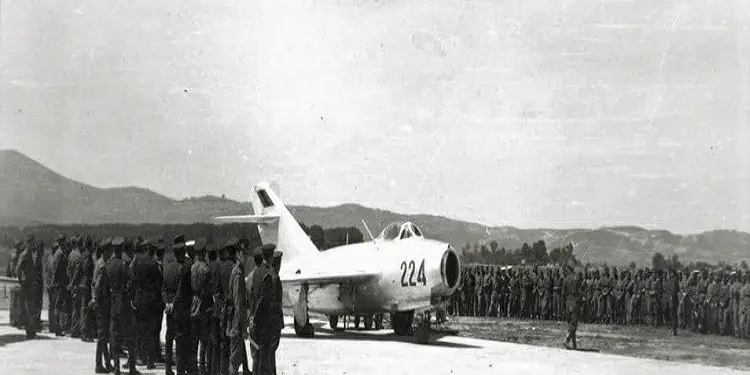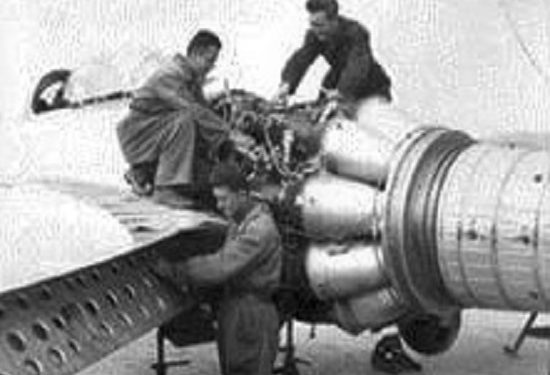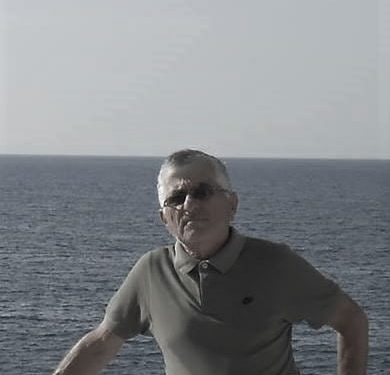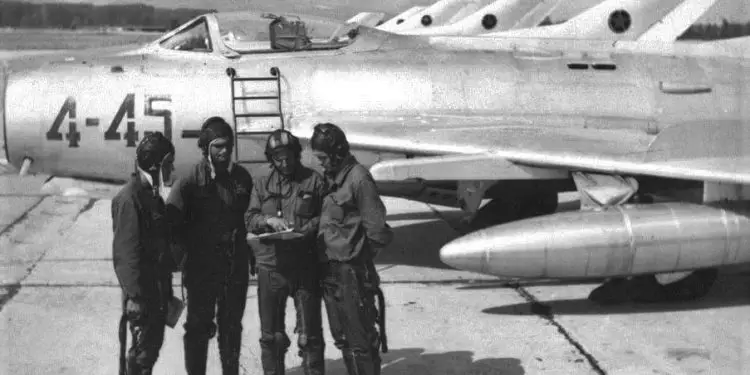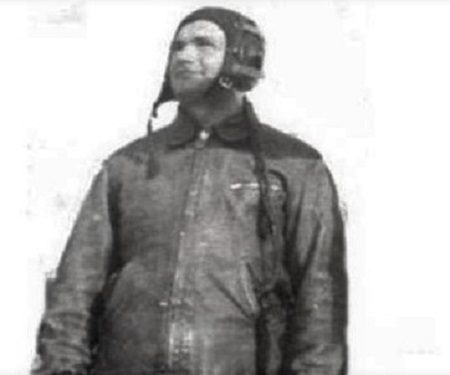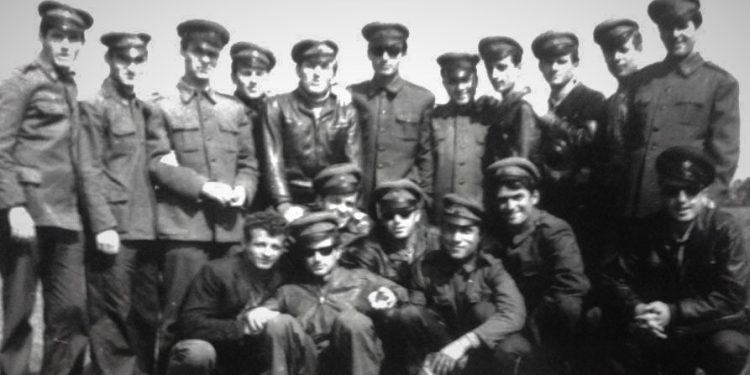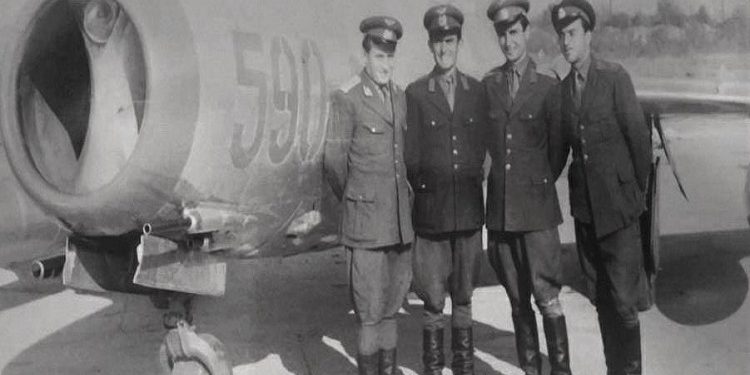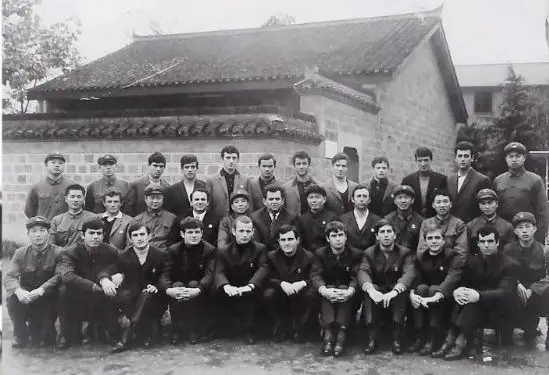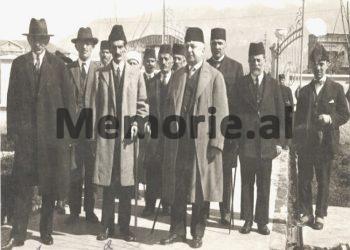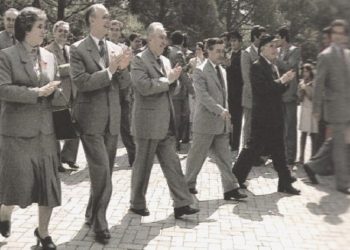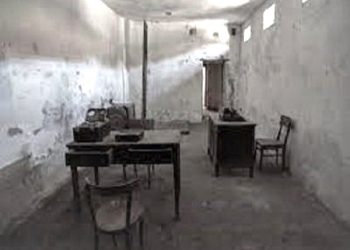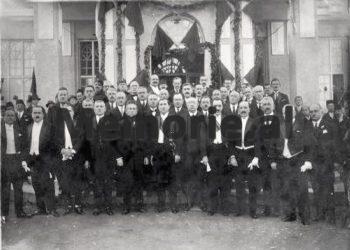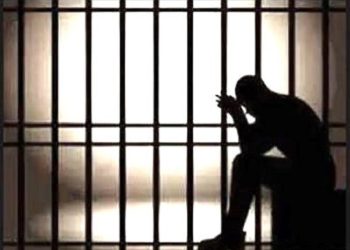By Nizai Nelaj
The ninth part
– At the Chinese Military Aviation School –
Memorie.al / Expelled from the Soviet School of Aviation, with dreams cut in half, part of the group of student pilots, who had studied for a year in the city of Bataysk, on January 8, 1962, after a “hell” cruise ”, with a cargo ship, we arrived at the center of China’s Third Military Aviation School in Chin Zhou City. It is located in the “heart” of Manchuria; at that time there were about 200,000 inhabitants. Without any prominent industry. A city with 2-3 story buildings but paved roads. The terrain around the city was plain; next to it are the Western shores of the Yellow Sea. One of the values of this city was the fact that it was the center of China’s Third Military Aviation School. My going to this school and that city was a lucky chance. In the list of 7 students of our course, which included: Adem Çeça, Dhori Zhezha, Mihal Pano, Bashkim Agolli, Andrea Toli and Sherif Hajnaj (Bracki), my name, Niazi Nelaj, was included, quite by chance?
Continues from last issue
The ‘Mig-15 Bis’ plane was a surprise for the US Air Force. The introduction, in the war, of the Mig-15 Bis jet plane, in the conflict between the two Koreas, was called the “Korean Surprise”. The new Soviet-made fighter jet had an airtight cabin, catapult system, powerful armament and was equipped with an oxygen supply system. At first, the ‘Mig-15’ plane was used in the Shanghai space, in the early 1950s, against Guomindan planes.
“Mig-ët-15” shot down only 1 “P-28” plane. In the years 1950-1953, MiG-15 aircraft took part in the capture and destruction of aircraft violating the airspace of the Soviet Union. In those years, four ‘RB-29’ planes were shot down over the Soviet territories; two ‘B-26 C’ planes; an ‘F-82’; an ‘F-51 D’; a ‘B-24’; a ‘P 2-4-3’; a ‘DC-3’; a ‘PBY-5A’; a ‘Lincoln B-11’; an ‘RB-50G’ etc.
The Korean War was the biggest test of several months for the ‘Mig-un-15 Bis’. It was the first air war between jet planes. With the entry of China into the war, the Soviet Union sent the 64th Rifle Corps to China, equipped with MiG-15 aircraft. On November 1, the corps entered the war against the American Air Force. This came as a surprise to the US Air Force, which had not anticipated the encounter with the new Soviet fighters. The American F-80 planes failed in front of the MiGs. At the end of December 1950, the Americans urgently introduced the F-86 (“Sejbr”) aircraft into combat.
Until the end of the Korean War in June 1953, the MiG-15 and the F-86 were the main aerial adversaries over Korean skies. A MiG squadron commander, Sergej Kramarenko, won 13 aerial battles in Korea. Soviet, Chinese and North Korean planes shot down 1,377 enemy planes in this war and left 566 of their own. The pilot, Evgeny Pepelayev, shot down 23 enemy planes. The Soviet planes had as aerodromes for taking off and landing, those of North-Eastern China.
The United States of America, the tax of 10,000 dollars for what would take the plane ‘Mig-15 Bis’ to that country. After the end of the Korean War, in September 1953, Soviet pilot Ho Gimsok, unaware of the price, landed a MiG-15 in South Korea, and from there the aircraft was placed in a museum of the USA.
The Chinese used the ‘Mig-un-15’ in the war against Taiwanese aircraft; in the Arab-Israeli war and in Vietnam, where this aircraft was widely used. So much for the story. Of course, these data are from Soviet sources. As for information, in our country, the Mig-15 Bis planes came from the Soviet Union in 1955. Initially, 18 combat planes and 4 other training planes arrived. The ‘Mig-15’ plane was removed from the armament of the Albanian Aviation, only in 2006.
Our country was the last in the world to do this. The ‘Mig-15’ airplane was baptized in Albania with the symbolic name: “Air Mule”; starting from the fact that it was stable, on the ground and in the air; maneuverable; suitable for our rugged mountainous terrain; it could land and rise even on the lawn and forgive the pilot even a small deviation from the flight parameters.
In our country, Mig-15 planes were assembled in Tirana, in the Transport Squadron; took off from the Aviation Field in Laprakë, piloted by Soviet pilots, then landed at the city aerodrome “Stalin”. With these planes and others that came later, the first regiment of the “Shooter-Bomber Aviation” of our country was formed, commanded by the “father” of the Albanian Combat Aviation, the unforgettable Niko Selman Hoxha. In the first group of pilots who were trained at the Soviet Aviation School in Borisoglebs, which was named after the famous “Valerij Çkallov”, were: Anastas Ngjela, Vasil Andoni, Agim Spahiu, Hamit Ulqinaku and Bardhyl Taçi.
Once upon a time, in Aviation regiments and Soviet schools, special pilots, with very balanced Mig-15 planes, practiced the ax; they even showed it to their colleagues. The numerous casualties that followed the implementation of the exercise led to the ban of this unpleasant figure for the pilots.
There were busy days of preparation on the ground where we underwent unprecedented work, imitating, with a model airplane in hand or, in the cockpit, all the actions that the pilot performs, from the moment he takes his seat in the cockpit; until he completes the task, he subtracts from it. It must be said that at this stage of preparation, Chinese patience stands out with all its strength.
In the days after the theoretical preparation, before the ground preparation started, I had to be hospitalized. To conclude about a long-standing pain in the right shoulder. The pain was not unbearable but disturbing. So I delayed the matter until I found a suitable time interval. In the fall of 1962, when the Manchurian winter had not yet set foot cross-legged in Liao Nin province, one day, in the company of my inseparable doctor and translator, I set off for the aviation hospital in the beautiful city of Changchun.
A “bump” hatched in the aviation military hospital in Çhang Chunit
It is about a “novel”, with no beginning and no end, in the fall of the distant year 1962, in the Manchurian city of Chang Chun. This city is located in the center of the province and stands out for some rare, characteristic beauties. In a place with dense picturesque greenery, who knows when and by whom, a beautiful, three-story, arch-shaped building, adapted for a hospital, was built.
The beauty of the surrounding environment corresponded in complete harmony with the cleanliness and order of the interior and an “exemplary” health service. It seemed as if in that health institution everything was made to order and with great care. After 1948, the year when China was liberated, this hospital served mainly Soviet military advisers and aviators, as well as some “weighty” cadres of the Chinese Liberation Army.
I can say that whoever won the lottery to be admitted to that health institution was lucky and “was born with a shirt”. I say it competently, it is completely true and I have experienced it myself, at the end of 1962, when I was diagnosed and treated for a shoulder pain.
Several times I had addressed the specialist doctor of the school, with the words: “It was; jou bin, let’s eat”! Which means: “Doctor, I’m impossible, my shoulder hurts”? The school doctor tried, with the opportunities he had and the knowledge he possessed, but he could not conclude whether it was pain of a muscular or bone nature. For competence, he directed me to the region’s aviation hospital; in the physiotherapy ward. The accompanying sheet and history were given to him by the “translator” who stuck to me like a “postage stamp”.
All that man, in vain, fat as an ox, lay down on a bed, parallel, in the room where I was assigned. His illness was quite difficult to identify. He ate, drank, slept, and passed the time by reading the newspaper. I resented him not only because I knew he was an informer for the Chinese Security, but also because of some vice, which I could not stand. That handsome man, in college, often took out phlegm and threw it wherever he could.
To put it as it was, the Chinese felt the burden of responsibility they had for the preservation of our health and did their best not to harm it. But, in the town where our school was, the possibilities were limited; the hospital was specialized. Our friend Bashkim Salih Agolli (Nipçja), one night, after midnight, was urgently sent to the hospital of the city of Chin Xout, in a surgical case, which resulted in acute appendicitis.
The doctors operated on him and saved his life, but the lack of experience caused the incision site to remain “like a cave”. My case was different; she waited. To conclude about the origin of my pain, it took time and special analysis. That’s why I was sent to Chang Chun.
Until that time I had learned to communicate in Chinese, only orally, in general words, as much as is necessary for general communication. It was difficult for me to understand and explain my case in the local language, in front of the white shirts, in medical terms. Therefore, the Russian speaker pretended to be sick, which did not leave me but monitored me 24 hours a day.
I was very angry when I spent the nights, almost without sleep, from the pain and saw the “sick” translator in the neighboring bed, sleeping for seven pairs of pleasures and snoring loudly. After the analyzes and specialized examinations, I was prescribed medication, which would continue for about two weeks. In the field of medicine, especially when physiotherapy comes into play, Chinese medicine is interesting and unique.
Perhaps it may be useful for the reader to tell him the type and method of treatment of an analogous case. It was a type of arthritis. How could I not have arthritis, with that childhood barefoot, waterless, not eating and sleeping in very miserable conditions?!
After the doctors concluded, in a treatment room, on the first floor, where the alcoves for each patient were separated by curtains and equipped with hard beds (not springs), I started to be treated. A strange treatment, without drugs and without suffering. It looked like a toy to me. Every day, in the early hours, I underwent a treatment session with warm paraffin.
The locals used to say to this treatment: “Lla ljao”. I lay on a piece of paraffin heated as much as the skin could bear, which was wrapped in white gauze; I put my aching shoulder on it and stayed like that for about 30 minutes. The heat of the paraffin was slowly absorbed by the body and, after 30 minutes, it was cold. After the treatment with warm paraffin, I went to a nearby alcove, where another type of treatment awaited me.
Sitting in a chair, the nurse pointed a kind of reflector at me, which sent warmth and rays to my sick shoulder. This was the medicine, which in the local language is called: “Li Ljao”. I stayed in the same position for 20-30 minutes; then I moved to another bed where they “bombarded” me, for 10-15 minutes, with ultrasounds.
This was my last resort. It was not deemed necessary to use acupuncture; nor the Chinese vendors. I did the same ritual every day. After two weeks I felt better. To this day, I have not felt shoulder pain like I remember.
At the place of treatment, I had seen how acupuncture was done. A very interesting and effective method, which I think has Chinese authorship and is used only in that country. A doctor (nurse), smart and resourceful, who perfectly knew the anatomy of the human body, held in her hand an “age”, quite thin (the size of a hair), with a tip, she placed it on the streets they passed blood vessels (veins) and pressed it a little, with a light push of the hand.
Such “ages” stuck in many places where the patient complained of pain and left them like that for about 20 minutes. After the necessary time, she, with a light hand, pulled out the “needles”, one by one. The patient felt nothing; like when “ages” were put on and when they were removed.
Their effectiveness was immediate; the dormant nerve was stimulated and it began to function normally. I believe, it did not require any special specialization, as long as our group friend – Dhori Nasi Zhezha, under the conditions of the department, learned to use this method of treatment, “dry”, without the use of medications.
My treatment continued for about 20 years; the rest of the time I had free and I didn’t know how to spend it. The many Chinese who were admitted to that hospital (of course, those who moved), played
Ping-pong. This game is quite widespread in Chinese areas. It had become, in time, a popular game and the locals were great masters in ping-pong.
In the aviation school, both in Chin Zhou and Sui Xun, I had learned to play, with and like my friends, but with the Chinese I could not compare. I was very angry with them but I was a little clumsy for this game. I was taught to play ping-pong by Perlat Lako, who allowed me to play cleanly, with long balls.
Perlati was quite accurate in receiving the ball and, when we played together, he allowed me to shoot. In the hospital I found great masters. I thought: chance knocked on my door; I have plenty of time, why not learn table tennis from these massive masters. I often went and stayed long in the ping-pong halls. The massification of this type of sport meant that there were queues in those halls. I benefited from playing and watching the locals play.
To respect me, many people left my turn. I felt bad for this kind of privilege. I saw myself as those who are guilty of sin. When I took the racket in my hand and played it in front of the Chinese, I realized how much my skin was worth. I was beaten by men, but also by women. They are fantastic and you can’t compare when it comes to the game of ping pong.
Ape-like dexterity stemming from reflexes was their main characteristic. They are also very angry. He noticed that you are better, the Chinese “eats himself with his teeth”, until you manage to stay behind him. This is not only felt in the game of table tennis, but in all areas of life. Sedra and cmira are two of the main driving forces that keep them motivated to move forward.
Standing often for a long time, in line to enter the game, I noticed a teenage girl, no more than 16 years old. The girl was about 165 cm tall. he was wearing dock clothes, military, khaki, trousers and a sweatshirt, the kind that are filled with cotton and woven. She wore long hair, down to her hips, braided in two braids. The girl had two eyes, black, with tails, as the Chinese have.
Her large, round, shining eyes resembled two eyes of a heifer. The facial features were round and fine. The color of her face was white, untouched by the sun. His nose was small, slightly depressed, his mouth was small and his lips were fragile. Her fragility and that childlike, innocent look resembled more of an angel than a human.
While waiting in line to play ping pong, the young lady caught my eye, not just once. I looked at him and he looked at me, not indifferent. I looked at her attentively, from head to toe, and she only laughed in response, with an innocent face. She, like me, waited her turn to play, carefree. As Chinese women stand, without caring what others say about their stand. Memorie.al
The next issue follows




